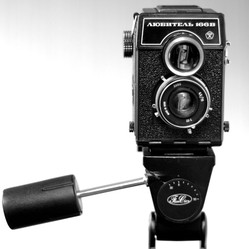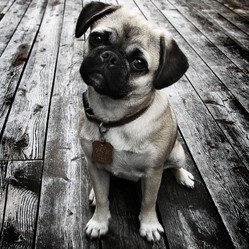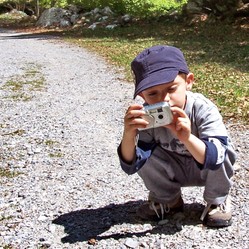
Photographic Style
by photography
The peculiar combination of methods favored, and the variation of degree in applying them, produce a particular style.
Any medium of artistic expression must allow a certain amount of control. The more flexible the medium, the more pronounced the style possible, because the artist is allowed greater scope in selection and emphasis.
When the style of an artist is well developed it shows consistent tendencies- his choice of subjects, the particular range and hue of colors he favors, his special manner of applying the paint, the effects of lighting he chooses-and so on. Any one of these things on its own would not give him style. But the very particular combination of effects he favors and the emphasis he gives to each, add up to a unique and singular arrangement. Alter or vary one of the effects and the sum no longer gives the same answer. That is style.
The medium of photography does not allow the same amount of individual control that is possible, for instance, in painting. But some control is possible; so the photographer can achieve a certain degree of style.
Seeing new things in photographic compositions
 | The Photographer's Eye: Composition and Design for Better Digital Photos Design is the single most important factor in creating a successful photograph. The ability to see the potential for a strong picture and then organize the graphic elements into... |
 |
Add individual style to your images
There are several ways in which the photographer can influence the final result of his work and thus create an individual style. The first is his choice of subject. He may have a liking for portraiture or he may find a peculiar attraction to landscapes. He may even narrow his outlook to special subjects like trees, or yachts, or flowers.
Next, a tendency to emphasize certain features of the subject may equally be something individual and singular. One photographer may strive to show Nature in his landscapes as rugged and fierce. With the same scene before him, another may (by choice of viewpoint and careful emphasis) depict nature as delicate and beautiful. This tendency of the photographer can be evident no matter what subject he chooses.
Exposure control is a easy and effective way to add a personal style
He can regulate exposure to concentrate interest on the highlights in a picture; or on the shadows.
He can vary or at least select the effect of lighting to give the picture depth and shape. Or he can go to the other extreme and display the subject flatly with no differentiation of planes. (Interest then would be concentrated on outline rather than form, pattern rather than shape.) In the same way he can emphasize or play down texture.
By suitably adjusting both exposure and lighting he can introduce predominantly high or low key tones with their attendant effects.
He may arrange the composition to make a picture appear graceful and passive. Or he can vary it to suggest vigor and movement.
Isolating subjects with selective focusing
By selective focusing he can concentrate interest on only one plane, or give an over-all sharpness to the picture. Or he can use diffusion to give the whole picture softness.
Even blur caused by camera shake or subject movement can be exploited to give a picture spontaneity or a feeling of action.
The photographer who has matured and developed a style will use devices such as these.
But it is his actual selection and combination of methods, and the consistent adoption of this pattern, that creates his style. It may not be the result of a conscious effort indeed it seldom is.
Style is dependent on the photographer's background, training and outlook. Generally, the more distinctly individual the photographer's character is, the more consistent and easily recognizable will be his style.
But while style itself is the result of the combination of a mass of details, the final product can only be general. This special pattern of method can only be seen by a broad, over-all examination of a photographer's work.
In fact, it is only its constant repetition that makes it style at all.
Style however should be individual. It is an intricate pattern, peculiar to the photographer.
Copy it and it becomes unconvincing and lacks the vitality of sincere art. Its development must be spontaneous and not forced, its growth natural and unhurried.
Sony NEX Cameras
The smallest APS-C cameras with very high image quality output
 |  |  |
| Sony NEX-6L/B Mirrorless Digital Came... | Sony NEX-5N 16.1 MP Compact Interchan... | Sony NEX-5R/B 16.1 MP Mirrorless Digi... |
Schools of Style
Just as the individual can have style, so can nations or communities. The style then is no less individual, but rather are the people who contribute to it less individual in their outlook. Such a unity of style among people is known as a school.
Photographs from certain countries will often show this tendency to a common style.
It may be the result of national characteristics. Or it may be a changing outlook reflecting economic and social conditions.
When just a group of people share a common style (although often still with personal differences) it is usually the result of a conscious and organized effort. This kind of common purpose inspired many of the great schools of painting. More often than not it begins as a revolt against convention or tradition in art. The unified outlook of the group then favors the natural development of a style.
Natural development- that is the essential condition of style, whether of the group or the individual. And style can only come naturally by forgetting about it.
In a photograph style makes the work original, belonging to one photographer and not any photographer. It is the stamp of the artist that renders a signature unnecessary.
Indeed, style is frequently the very means by which unsigned work is identified.
You might also like
Photographing Dogs and PuppiesPhotographing dogs is difficult. The best tip to anyone attempting to take pi...
Tricking the Subject


 Interchangeable Lenseson 09/28/2011
Interchangeable Lenseson 09/28/2011
 Negative Blisters and Blemisheson 09/17/2011
Negative Blisters and Blemisheson 09/17/2011
 Photographyon 08/22/2011
Photographyon 08/22/2011
 Daguerreotypeon 08/24/2011
Daguerreotypeon 08/24/2011



Comments